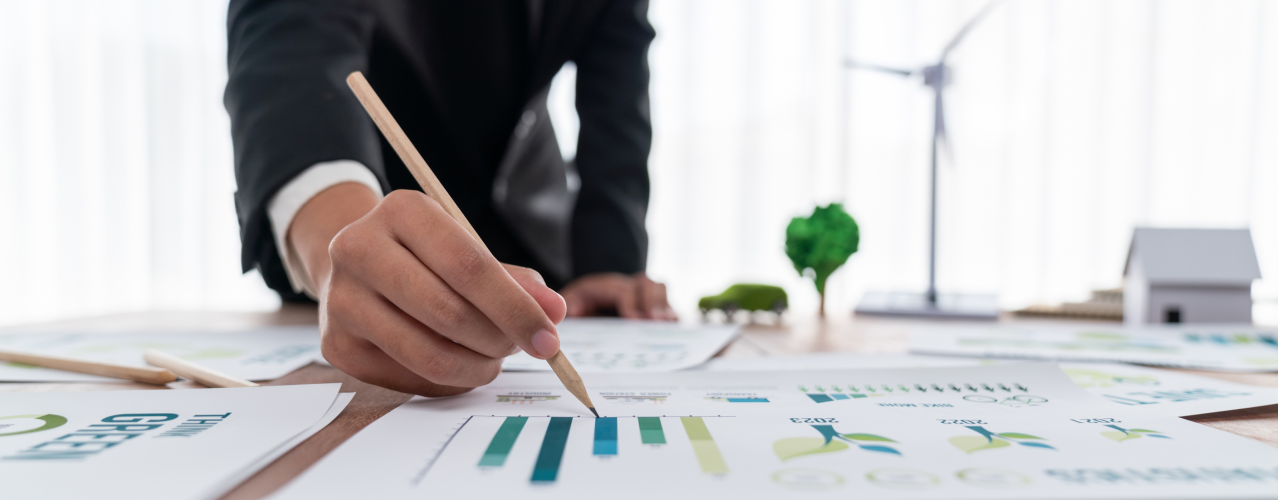

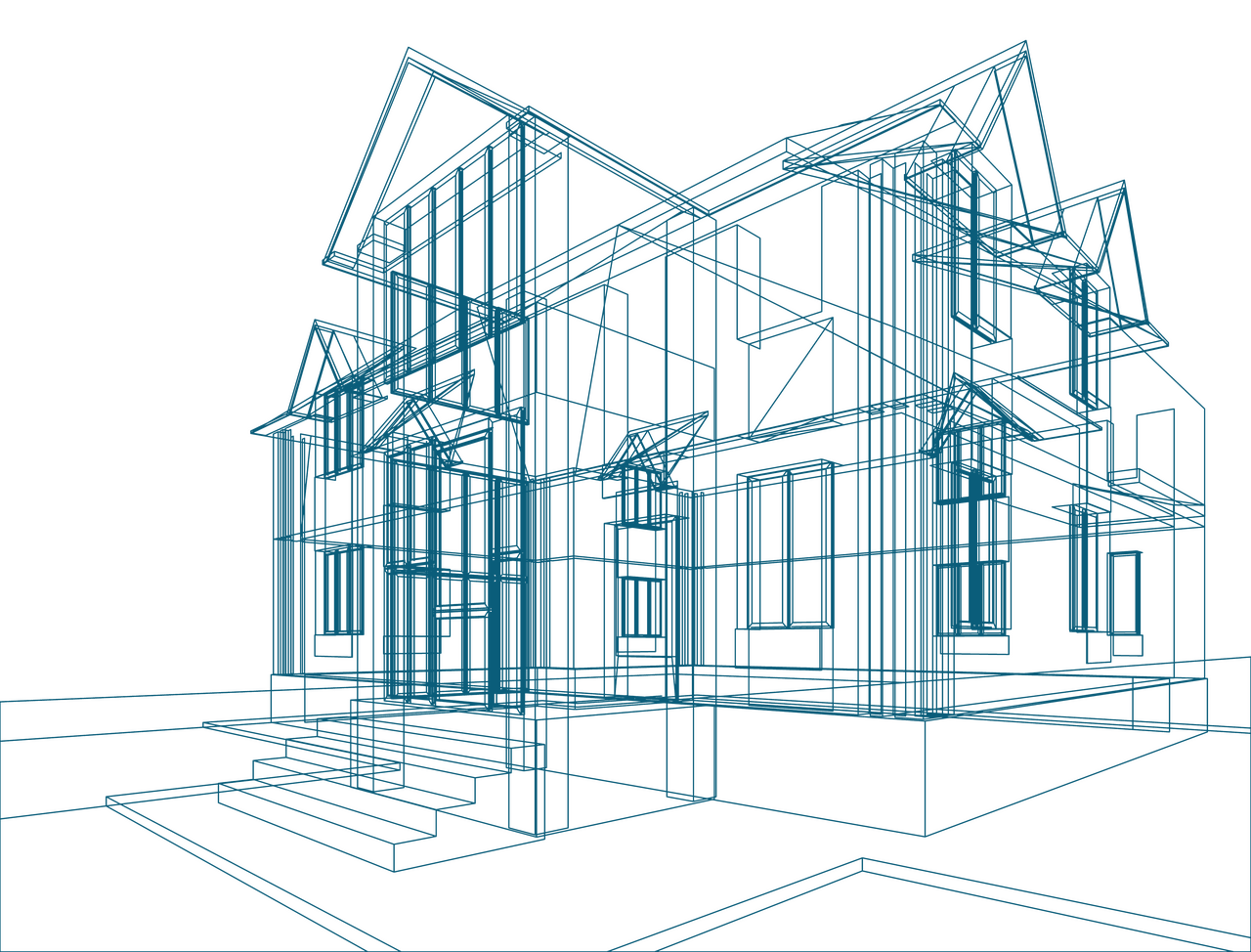
Market report
Sustainable construction trend
Gain valuable insights into the European architectural market with the European Architectural Barometer report from USP Research. Stay informed and make strategic business decisions based on industry trends and data.
News I published 12 October 2022 I Dirk Hoogenboom
Sustainable construction trend: architects continue to use fewer but more sustainable materials
Major trends in the construction and installation sector, as well as in society at large, ultimately affect the choices for materials and products used to construct the buildings around us. Because of their involvement in early stages of the construction process, architects have a high prediction value for many trends in the construction and installation sector, including trends and developments in materials used for building construction in all its facets.
That is why every other year, we dedicate one quarterly report of USP Marketing Consultancy’s European Architectural Barometer to material usage in building construction. For that report, we measure architects’ expectations of materials specified for building construction in the coming five years to construct a clear picture of the developments in materials used. Based on our interviews with architects from eight European countries in the second quarter of 2022, we can conclude that architects generally expect to specify and use fewer materials in the coming years.

Architects expect to use fewer materials
Across all countries, architects expect to use fewer materials for certain purposes or elements of a building. That is, they expect to use a smaller variety of types of construction materials. Those expectations started to appear in our measurement in 2020. In the 2022 measurements, we see that for the coming years, architects generally continue to expect using a smaller variety of materials.
This is the case for many materials in the ten product groups or building parts we interviewed architects about. Looking at building façades, for instance, architects expect to specify less concrete, plaster, architectural glass, metal and fewer bricks and external drywall systems. The only product type they expect to specify more is façade panels. A similar expected reduction of the majority of specified materials can be seen in both pitched and flat roof materials, flooring materials, metals in general, and quite a few materials used for the building envelope.
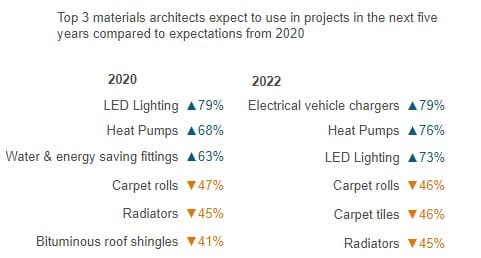
Exceptions show the quest for sustainability
Given that architects generally expect to specify fewer materials, it is more interesting to look at the exceptions to that statement. Doing so, it becomes clear that the common denominator for most of the materials that architects actually expect to specify more in the years to come is sustainability. Since buildings and building construction use up many resources and are major contributors to annual emissions of greenhouse gasses and pollution, it stands to reason that efforts are taken to make this sector more sustainable.
That sustainability trend is reflected by the few product or building part categories in which a majority of materials are actually expected to be specified more. In the category of insulation, for instance, architects expect to specify all types of insulation material more, except for polystyrene foams. As for installations and climate control, architects also expect to specify all sorts of materials and systems more, except for gas boilers and radiators.
The sustainability trend is not just reflected by better insulation, more heat pumps and fewer gas boilers, however. Looking at other categories, we see that architects expect to opt more often for renewable materials like timber, and fewer plastics and other oil-based materials. These are but few examples of the long list of materials we asked architects from eight European countries about. For a full overview of expected developments in materials used for building construction, we refer you to the Q2 2022 report of USP Marketing Consultancy’s European Architectural Barometer.

Read more
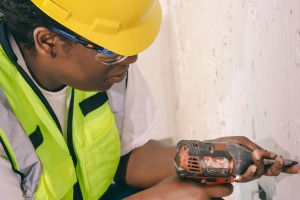

12 December 2024 I Dirk Hoogenboom
Buying Behavior of Handymen
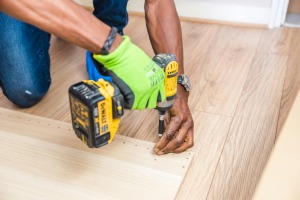

12 December 2024 I Henri Busker
Handymen Radar – Private Labels vs. Branded Products


12 December 2024 I Dirk Hoogenboom
Sustainability and Painting – What Matters Most?
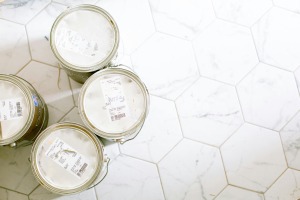

12 December 2024 I Zeynep Kutsal
Are European Painters Getting Younger?

Fresh Insights Await
Our relevant reports
Delve into the newest findings across various market segments, crafted for a cutting-edge overview. Explore our insightful reports, brimming with up-to-date data, trend analyses, and in-depth examinations, all tailored to provide you with a comprehensive understanding of the current market dynamics.
Construction
Home Improvement
Installation
Special reports
Construction
Smart Materials and Buildings Q4 2024
2024 85 pages
Explore the evolving future in construction sector among European architects in Q4 2024. Delve into the factors driving material preferences and the impact on construction aesthetics and sustainability.
2,000 Euro
Construction
Digitalisation and BIM H2 2024
2025 64 pages
Uncover the preferred purchase channels of contractors in H2 2024, and understand how purchasing behaviors evolved. This report provides insights into the factors influencing purchasing decisions among contractors.
6,000 Euro
Construction
Decision making process Q3 2024
2024 87 pages
Unveil the decision-making processes in the construction industry through the lens of European architects. Discover the factors that influence crucial decisions and the interplay among different stakeholders.
2,000 Euro
Construction
Prefab H1 2024
2024 63 pages
Discover the adoption rate and benefits of prefabrication technology among European contractors in H1 2024. Understand the driving forces behind prefab usage and its impact on project efficiency and cost-saving.
6,000 Euro
Construction
Future of construction Q2 2024
2024 82 pages
Explore the evolving future in construction sector among European architects in Q2 2024. Delve into the factors driving material preferences and the impact on construction aesthetics and sustainability.
2,000 Euro
Construction
Sustainability 2024
2024 72 pages
Painter Insight Monitor 2024 will focus on understanding the specific needs, preferences, and challenges faced by painters when it comes to sustainable products.
11,000 Euro
Home Improvement
DIY vs DIFM Q4 2024
2025 76 pages
Explore the prevailing trends between DIY and DIFM in Q4 2024. Understand consumer preferences and the factors influencing their choice between DIY and DIFM.
3,500 Euros
Home Improvement
Branding Q3 2024
2024 74 pages
Discover the power of branding in the home improvement sector. Explore how strong branding influences consumer preferences and purchase decisions.
3,500 Euro
Home Improvement
European Garden Monitor
2023 43 pages
Explore the European Garden Monitor, a comprehensive platform dedicated to garden health monitoring in Europe. Access valuable resources and expert advice today.
12,000 Euro
Home Improvement
Purchase channels Q2 2024
2024 90 pages
The European Home Improvement Monitor offers valuable insights on purchase channels in the European home improvement industry, examining the evolving preferences and behaviors of consumers across traditional retail and emerging online platforms.
3,500 Euro
Home Improvement
Sustainability Q1 2024
2024 81 pages
Delve into sustainability trends in the home improvement sector in Q1 2024. Discover consumer preferences and the shift towards eco-friendly home improvement solutions.
3,500 Euro
Home Improvement
DIY versus DIFM Q4 2021
2024 113 pages
This report is a must-have if you’re in the home improvement industry. It provides a wealth of information on the behaviour of DIY and DIFM consumers, their motivations, and the factors that influence their purchasing decisions.
3,150 Euro
Installation
Training needs Q1 2025
2025 100 pages
This report offers an overview of installers’ habits and preferences concerning their education. Furthermore, the report encompasses the pervasive challenge of workforce shortage and explores the sector’s strategies for resolving this issue.
3,250 Euro
Installation
Media orientation Q4 2024
2025 128 pages
The European Mechanical Installation Monitor report provides a detailed analysis of the plumbing and HVAC industry. This report specifically focuses on Media Orientation in the industry.
2,800 Euro
Installation
Services in the installation sector Q4 2024
2025 102 pages
This report provides a comprehensive view of the installer's requirements for services from manufacturers. Within the report, you will find information on the most needed services in each category: commercial processes, engineering, products & installation, and repair & maintenance. It also examines the services that installers offer to their customers.
3,250 Euro
Installation
Prefab Q3 2024
2024 110 pages
Uncover the adoption of prefabricated products in HVAC installations during Q2 2022. Delve into the benefits and challenges associated with prefabrication in HVAC.
2,800 Euro
Installation
Prefab Q3 2024
2024 119 pages
This report offers a comprehensive view of the installers’ involvement and needs regarding prefabricated electrical installations.
3,250 Euro
Installation
Smart & Connected Products Q2 2024
2024 120 pages
This report provides a comprehensive view of the attitudes of installers toward smart building solutions, specifically among electrical installers and their clients. In the report, you will find insights into the installers' experiences with installing smart products and the willingness of end users to invest in such solutions, as well as their motivations and pain points.
3,250 Euro
Special reports
European Sustainability Report 2024
2025 51 pages
This report provides in-depth insights based on triangulation of key market information and data as well as data from USP Marketing Consultancy’s key monitors that are carried out year in, year out. The focus of this report is on the most important stakeholders within the construction industry, namely architects, contractors, electrical and HVAC installers within The United Kingdom, The Netherlands, Belgium, Germany, Poland, France, Italy, and Spain.
3,950 Euro
Special reports
European Sustainability Report 2024
2024 51 pages
This report provides in-depth insights based on triangulation of key market information and data as well as data from USP Marketing Consultancy’s key monitors that are carried out year in, year out. The focus of this report is on the most important stakeholders within the construction industry, namely architects, contractors, electrical and HVAC installers within The United Kingdom, The Netherlands, Belgium, Germany, Poland, France, Italy, and Spain.
3,950 Euro









